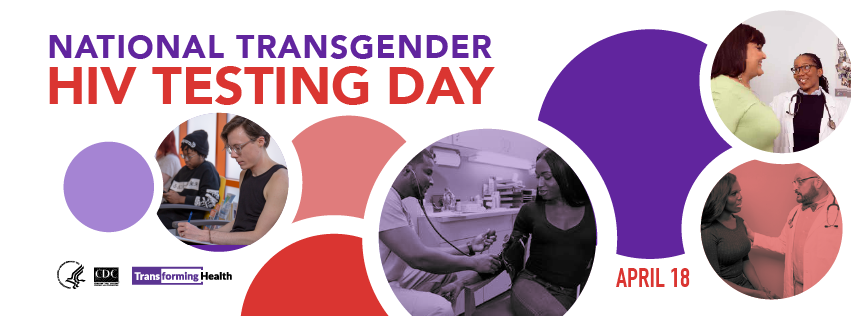National Transgender HIV Testing Day
Topics
Cross-posted from National Center for HIV/AIDS, Viral Hepatitis, STD, and TB Prevention

Dear Colleague,
Today is National Transgender HIV Testing Day, established by the Center of Excellence for Transgender HealthExit Disclaimer at the University of California, San Francisco. Please join us on this day for a call to action to promote HIV testing, prevention, and treatment efforts for transgender communities and work with all transgender people to protect their health through testing and knowing their HIV status.
Transgender women and men are at high risk for getting HIV. According to current estimates, about 1 in 7 (14%) transgender women have HIV, and the percentage is much higher among black/African American (44%) and Hispanic/Latina (26%) transgender women.* An estimated 3% of transgender men have HIV.
Expanding culturally appropriate, focused HIV testing efforts is one key to eliminating these disparities and reducing HIV’s impact on transgender communities. People benefit from getting a diagnosis as early as possible and starting treatment right away. People with HIV who take antiretroviral therapy as prescribed and stay virally suppressed can live long, healthy lives and have effectively no risk of sexually transmitting HIV to partners. For people at risk of getting HIV but who do not have the virus, testing can be the door to effective prevention options like pre-exposure prophylaxis (PrEP).
Many transgender people face obstacles that make it harder to access HIV services—such as stigma and discrimination, inadequate employment or housing, and limited access to welcoming, supportive health care. Addressing these barriers is essential to the health and well-being of transgender people and to meeting the goals of the proposed federal initiative Ending the HIV Epidemic: A Plan for America. The Centers for Disease Control and Prevention (CDC) is committed to working with you to make sure all transgender people can get the tools they need to prevent HIV and stay healthy if they have HIV.
Several of CDC’s HIV prevention activities focus on transgender populations. For example, CDC:
- Awarded nearly $11 million per year for 5 years, starting in 2017, to 30 community-based organizations to provide HIV testing to young gay and bisexual men and transgender persons of color.
- Identified the Couples HIV Intervention Program [PDF, 988KB] as an evidence-based intervention focusing on transgender women and their primary cisgender male partners. The program is part of CDC’s Compendium of Evidence-Based Interventions and Best Practices for HIV Prevention.
- Supports demonstration projects that provide PrEP services and data-to-care activities prioritizing gay and bisexual men and transgender people at high risk of getting HIV, particularly people of color.
- Is conducting a National HIV Behavioral Surveillance (NHBS) activity that includes a behavioral interview and HIV testing among transgender women at 10 sites across the United States.
- Developed communication materials to reach transgender people through its Let’s Stop HIV Together (formerly Act Against AIDS) campaigns. These campaigns are aimed at stopping HIV stigma and promoting testing, prevention, and treatment. Stigma materials and individual campaigns include storiesExit Disclaimer and issues relevant to transgender people:
- Transforming Health gives providers tools for delivering patient-centered HIV care for all transgender patients.
- Doing It encourages all adults to get tested for HIV and know their status. It includes images [PDF, 1.1MB] and videos featuring transgender leaders.
- HIV Treatment Works encourages people with HIV to stay in care. It features transgender women’s storiesExit Disclaimer of staying healthy with HIV.
- Start Talking. Stop HIV. helps gay and bisexual cisgender and transgender men communicate about safer sex, testing, and other HIV prevention issues.
Thank you for the hard work you are doing to stop new HIV infections among transgender people and help those with HIV stay healthy. We look forward to working with you to reach a future free of new HIV infections.
Sincerely,
/Eugene McCray/
Eugene McCray, MD
Director
Division of HIV/AIDS Prevention
National Center for HIV/AIDS, Viral Hepatitis, STD, and TB Prevention
Centers for Disease Control and Prevention
www.cdc.gov/hiv
/Jonathan H. Mermin/
Jonathan H. Mermin, MD, MPH
Rear Admiral and Assistant Surgeon General, USPHS
Director
National Center for HIV/AIDS, Viral Hepatitis, STD, and TB Prevention
Centers for Disease Control and Prevention
www.cdc.gov/nchhstp
* Estimates for transgender women overall and transgender men include laboratory-confirmed infections only. Estimates by race/ethnicity include laboratory-confirmed and self-reported infections.